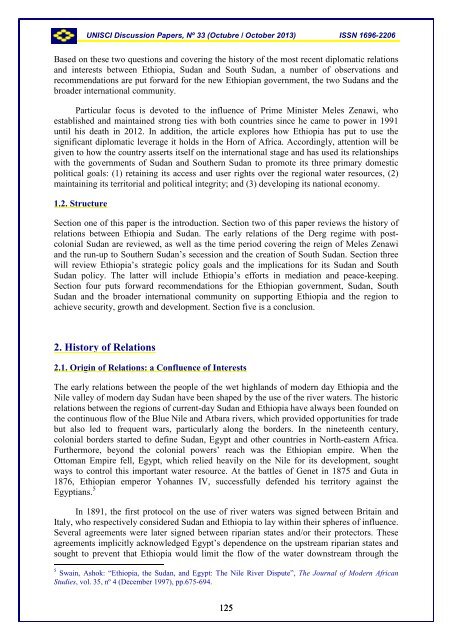UNISCI - Universidad Complutense de Madrid
UNISCI - Universidad Complutense de Madrid
UNISCI - Universidad Complutense de Madrid
You also want an ePaper? Increase the reach of your titles
YUMPU automatically turns print PDFs into web optimized ePapers that Google loves.
<strong>UNISCI</strong> Discussion Papers, Nº 33 (Octubre / October 2013) ISSN 1696-2206Based on these two questions and covering the history of the most recent diplomatic relationsand interests between Ethiopia, Sudan and South Sudan, a number of observations andrecommendations are put forward for the new Ethiopian government, the two Sudans and thebroa<strong>de</strong>r international community.Particular focus is <strong>de</strong>voted to the influence of Prime Minister Meles Zenawi, whoestablished and maintained strong ties with both countries since he came to power in 1991until his <strong>de</strong>ath in 2012. In addition, the article explores how Ethiopia has put to use thesignificant diplomatic leverage it holds in the Horn of Africa. Accordingly, attention will begiven to how the country asserts itself on the international stage and has used its relationshipswith the governments of Sudan and Southern Sudan to promote its three primary domesticpolitical goals: (1) retaining its access and user rights over the regional water resources, (2)maintaining its territorial and political integrity; and (3) <strong>de</strong>veloping its national economy.1.2. StructureSection one of this paper is the introduction. Section two of this paper reviews the history ofrelations between Ethiopia and Sudan. The early relations of the Derg regime with postcolonialSudan are reviewed, as well as the time period covering the reign of Meles Zenawiand the run-up to Southern Sudan’s secession and the creation of South Sudan. Section threewill review Ethiopia’s strategic policy goals and the implications for its Sudan and SouthSudan policy. The latter will inclu<strong>de</strong> Ethiopia’s efforts in mediation and peace-keeping.Section four puts forward recommendations for the Ethiopian government, Sudan, SouthSudan and the broa<strong>de</strong>r international community on supporting Ethiopia and the region toachieve security, growth and <strong>de</strong>velopment. Section five is a conclusion.2. History of Relations2.1. Origin of Relations: a Confluence of InterestsThe early relations between the people of the wet highlands of mo<strong>de</strong>rn day Ethiopia and theNile valley of mo<strong>de</strong>rn day Sudan have been shaped by the use of the river waters. The historicrelations between the regions of current-day Sudan and Ethiopia have always been foun<strong>de</strong>d onthe continuous flow of the Blue Nile and Atbara rivers, which provi<strong>de</strong>d opportunities for tra<strong>de</strong>but also led to frequent wars, particularly along the bor<strong>de</strong>rs. In the nineteenth century,colonial bor<strong>de</strong>rs started to <strong>de</strong>fine Sudan, Egypt and other countries in North-eastern Africa.Furthermore, beyond the colonial powers’ reach was the Ethiopian empire. When theOttoman Empire fell, Egypt, which relied heavily on the Nile for its <strong>de</strong>velopment, soughtways to control this important water resource. At the battles of Genet in 1875 and Guta in1876, Ethiopian emperor Yohannes IV, successfully <strong>de</strong>fen<strong>de</strong>d his territory against theEgyptians. 5In 1891, the first protocol on the use of river waters was signed between Britain andItaly, who respectively consi<strong>de</strong>red Sudan and Ethiopia to lay within their spheres of influence.Several agreements were later signed between riparian states and/or their protectors. Theseagreements implicitly acknowledged Egypt’s <strong>de</strong>pen<strong>de</strong>nce on the upstream riparian states andsought to prevent that Ethiopia would limit the flow of the water downstream through the5 Swain, Ashok: “Ethiopia, the Sudan, and Egypt: The Nile River Dispute”, The Journal of Mo<strong>de</strong>rn AfricanStudies, vol. 35, nº 4 (December 1997), pp.675-694.125
















